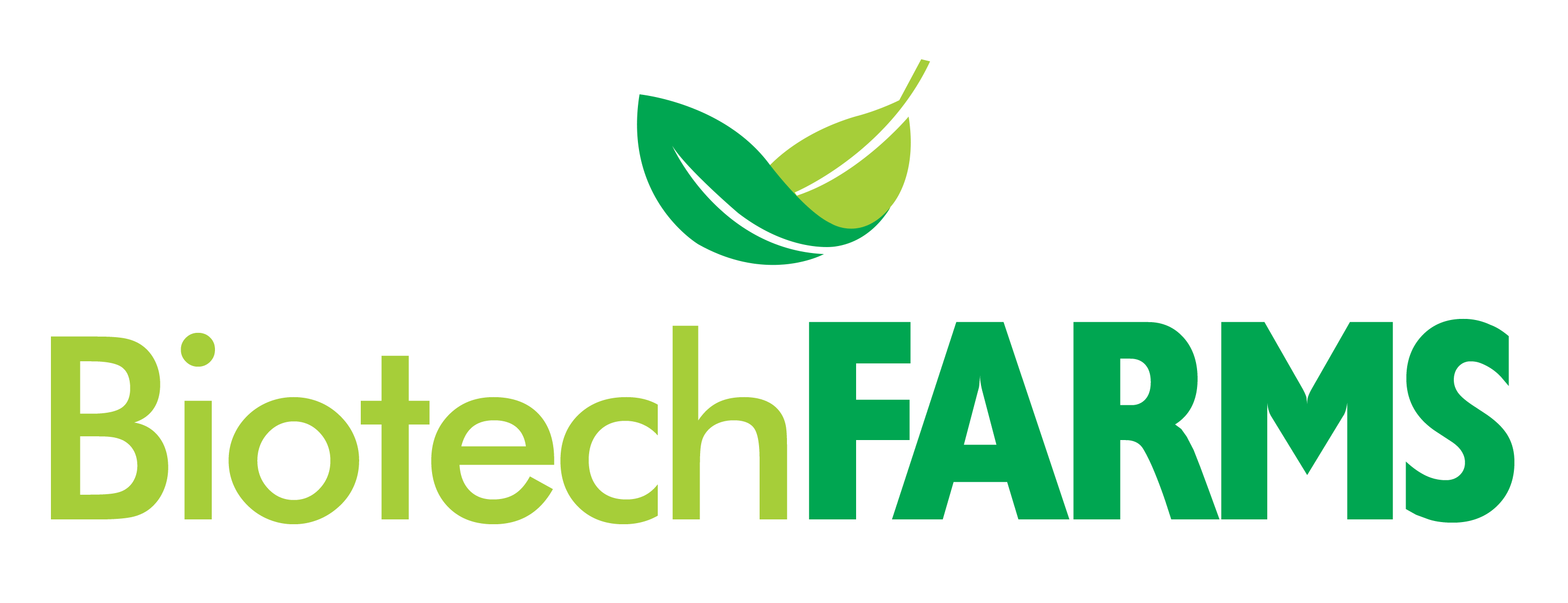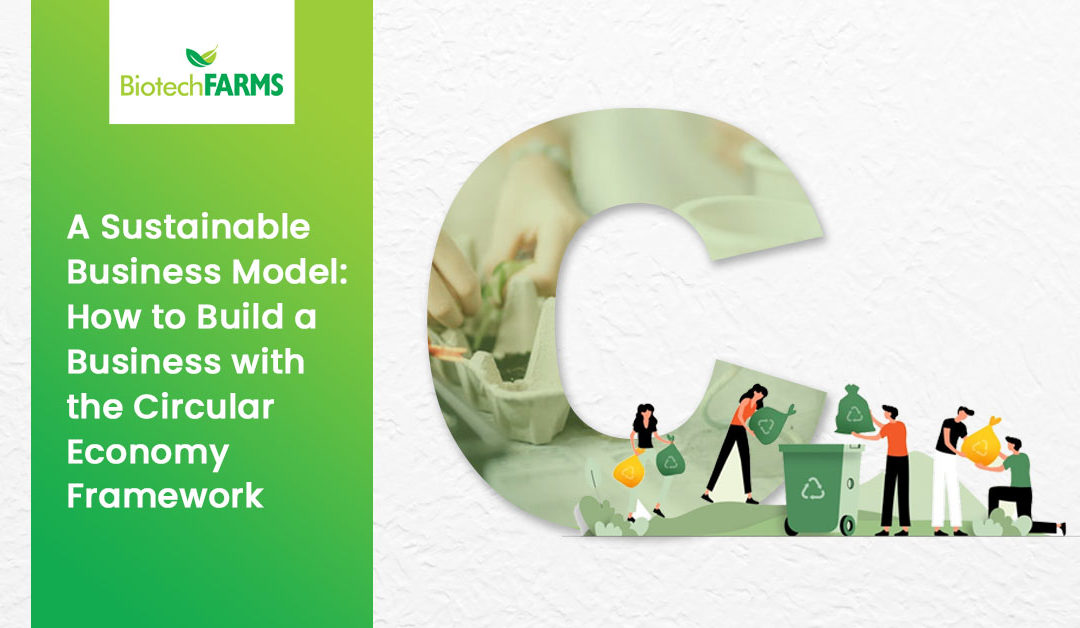The global economy is built on the “take-make-waste” linear model where natural resources are extracted, used, and end up as waste.
This is an inefficient model that is pushing the planet to the brink.
Due to rising resource prices, the massive increase in global consumption, and heightened environmental concerns, this model has come under pressure.
It is further driving the climate crisis and depleting the resources we need for the future.
Peter Lacy, managing director of Accenture Strategy and co-author of the book Waste to Wealth, said “The take, make and waste approach of traditional, linear business models has now begun to choke economic growth through unpredictable raw material prices and the increased cost of depending on less stable supplies of constrained resources.”
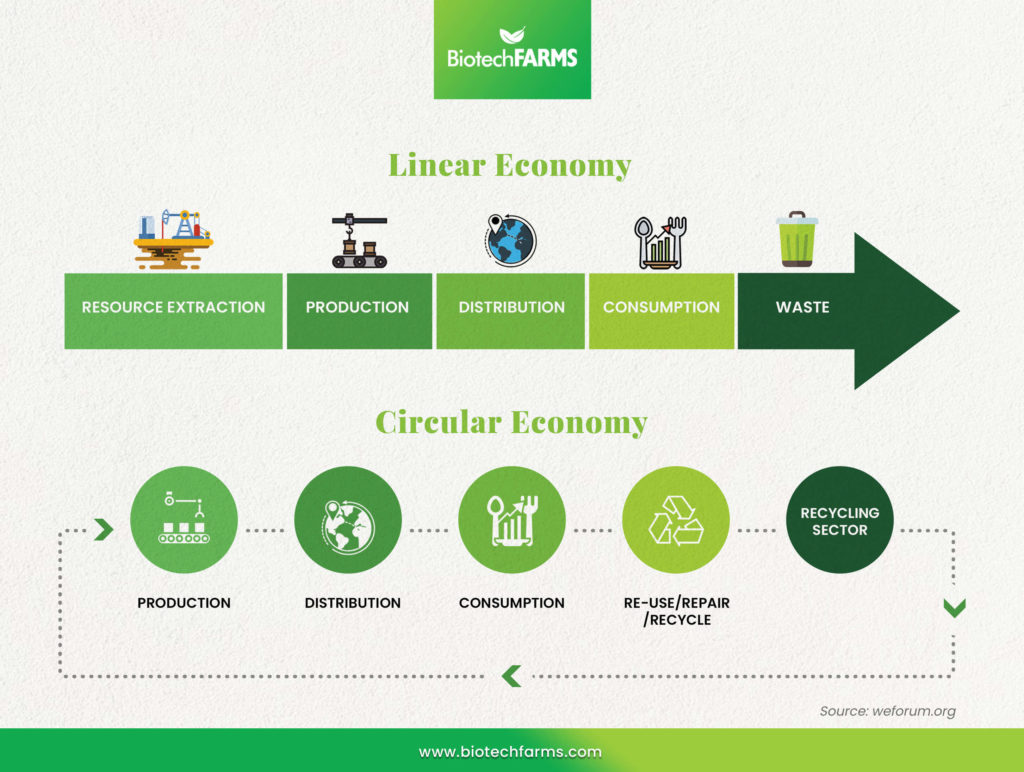
Studies show that creating a circular economy offers a $4.5 trillion economic opportunity by avoiding waste and at the same time also creating business growth and employment opportunities.
“By turning waste into wealth with new business models, companies can boost their competitiveness by reducing dependence on scarce resources and generating new innovative services that grow revenues,” Lacy added.
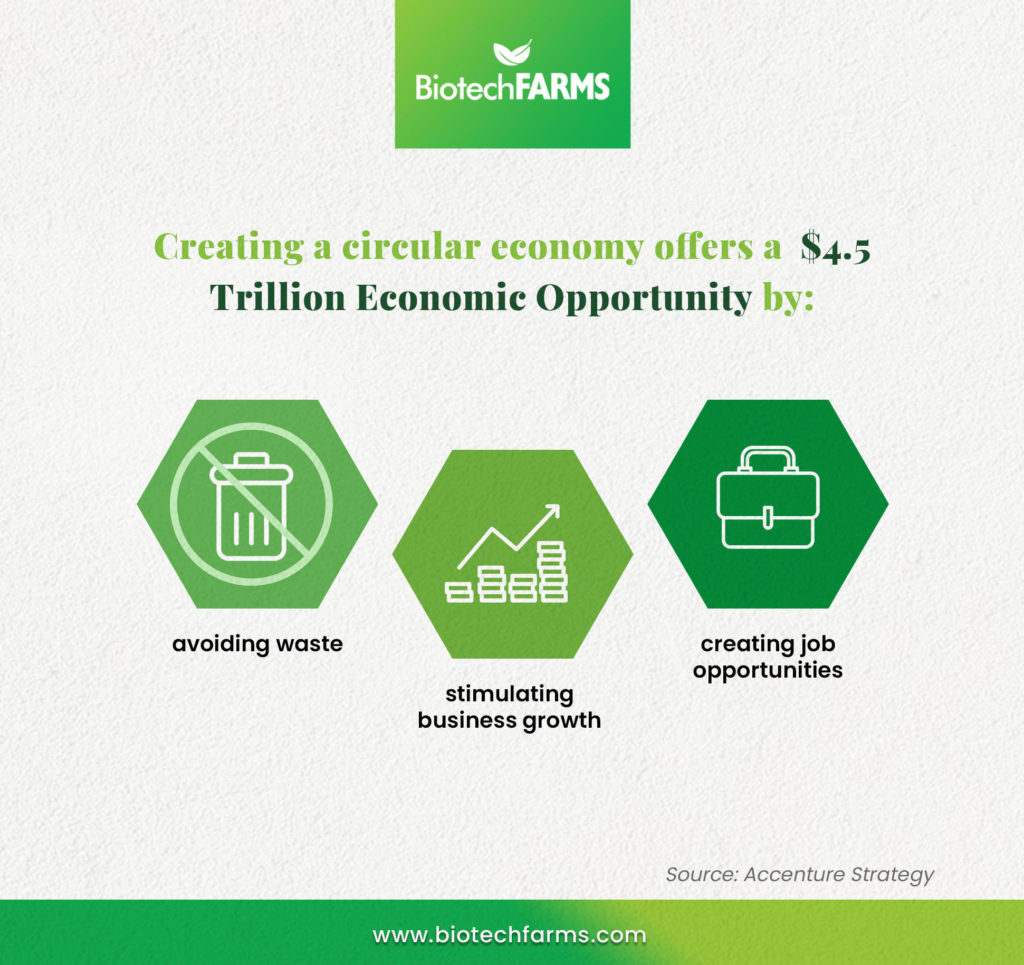
The critical insight behind the circular economy model is to think of waste not as waste but as a resource. This view is in contrast with the widespread and traditional view of waste as something useless with a price lower than zero.
The primary objective of this model is to break the link between economic growth and the consumption of natural resources so that the world’s economic well-being will no longer be tied to environmental destruction.
This is why we need to shift our perspective and encourage businesses to build a circular economy wherein waste and pollution are designed out in the first place. Products and materials stay in use for much longer so that natural systems can regenerate.
Here are several ways to address waste consumption:

Consume Less
The circular economy is centered on using natural resources since the world consumes far too many resources that it’s depleting more than it can regenerate. During the 20th century, the world used raw materials at twice the rate of the population growth. At the height of the industrial revolution, the fundamental principle for most business models is to sell more products to more people.
Disrupting this consumption issue that has been persisting for the past two centuries will require business innovation, policy support, and consumer demand. For developed economies with a growing base of middle-class consumers, the role of behavior change and policy incentives is essential to create a systemic change that will nudge consumers in the right direction.
For instance, cutting the usage of single-use plastic bags is a common concern. As such, around 127 countries have already introduced some form of regulatory measures to ban or tax its use.
Consume Better
It’s important to note that the circular economy is more than just about lessening consumption. It also involves the concept of better consumption. For consumers, this means changing the way they purchase products by choosing options that are produced in more sustainable practices, or that can be recycled.
The shift towards better consumption offers huge opportunities for innovative companies to adapt to a new and more sustainable business model. Consumer awareness of sustainable business models is also on the rise. A study shows that a majority of consumers (at 81%) reiterated that they expect brands to do what is right. The growing consumer pressure is also an essential factor that encourages businesses to change their unsustainable practices and governments to introduce regulatory policies that promote better consumption.
Create Systemic Change
When the entire economy is still inherently built based on the linear take-make-waste model, behavioral change from consumers can only go so far. There should be a paradigm shift that will bring about a systemic change in the global economy. With this, sustainability will no longer depend on consumer choices alone.
The core principle of the circular economy is to design products that are made to last with components and materials that can be used again. As more and more governments worldwide introduce policies that encourage recycling and reusing, consumer awareness of sustainability will also continue to increase. With these in place, companies that are starting to adopt a circular business model will find themselves at a clear advantage.
Benefits of the Circular Economy Business Model
Forward-thinking business ventures all have the goal of becoming self-sustaining. The circular economy concept works towards achieving that goal by increasing asset longevity and gradually reducing waste. Being “restorative and regenerative by design,” the circular economy is all about making tools and products last longer, reducing waste, and maximizing assets. Here are five excellent benefits to consider this business model for your own organization:

BENEFIT 1: It extends the life and value of products.
One of the main benefits of the circular economy is the extension of the value and lifecycle of individual products. Instead of developing products that quickly wear out and needs to be replaced, the circular economy focuses on maintaining the value of products through maintenance, upgrades, repairs, or remarketing.
While developing superior and more sustainable products requires a more significant investment from the manufacturer and the consumer, it also opens new opportunities for additional products and services. It also builds the reputation of the company since more consumers will patronize the brand because they know it’s reliable.
BENEFIT 2: It forms new revenue streams.
Product maintenance which includes upgrades, remanufacturing, and other similar processes, can become an opportunity for additional revenue streams. Product servicing becomes an integral part of the relationship between a manufacturer and consumer. As seen in tech companies, a satisfactory experience with customer service tech support will help boost the loyalty between a customer and the brand.
Another opportunity is the rise of “products as a service” business ventures. These are businesses that focus on leasing or renting items instead of selling them. Following the same structure of a subscription model, the assets never leave the ownership of the company. When products reach the end of their rental lifespan, they can be repurposed, upgraded, or sold to maximize profits.
BENEFIT 3: It allows resources to recover.
The linear business model forces companies to continue manufacturing new products to replace those nearing the end of their lifespan. This creates a never-ending cycle to keep up with market demand. When a company runs out of raw materials, it will have to wait until it’s replenished or restocked, which can cause an entire manufacturing chain to be suspended.
However, the circular economy is known for being “regenerative by design.” This model creates a buffer of time between the sale of one model and the sale of the next. Products with a longer lifespan allow companies to have enough recovery time to develop a better model instead of rushing to manufacture immediately. This allows enough time to replenish resources and materials.
BENEFIT 4: It helps manage assets more effectively.
Another benefit of allowing recovery time and regeneration is that it enables companies to manage their existing assets more efficiently. The circular economy model falls under the “reduce, reuse, recycle” philosophy which makes assets management vital to the company’s sustainability. Here are several examples on how this works:
- Maximizing product lifespan will minimize the required investment for production costs.
- Keeping track of unsold goods allows for effective repurposing or upcycling of unused assets.
- A balanced approach to production allows companies to redirect their resources based on their current needs.
BENEFIT 5: It helps companies find hidden assets.
Adopting a circular economy business model focuses on turning underutilized products or services into valuable company assets. It poses a challenge for businesses to find “hidden” assets within the company that could be used to reduce waste and provide extra revenue.
This aspect requires creativity and innovation with a little penchant for an outside-the-box mentality. An innovative entrepreneurial spirit requires organizations to think outside the box to turn their “cold” assets into “gold” assets with the circular economy models.
Four Different Ways to Make Businesses More Circular
Maximizing assets through effective resource management that focuses on product quality rather than quantity will create a workable and efficient circular economy business model. In the end, it will benefit the company, the consumer, and the environment.
Organizations can start engaging with the circular economy in four different ways. Here’s how they can make the choice:
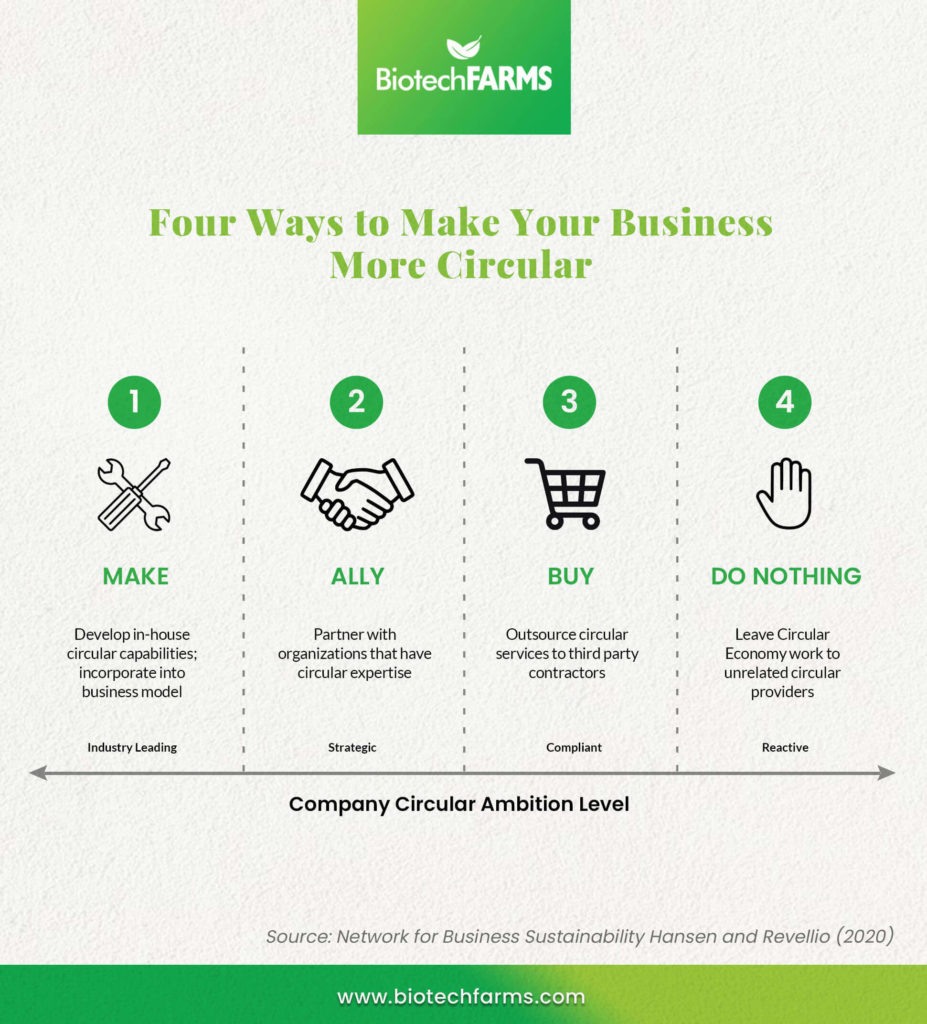
-
Make
This is the industry-leading approach in which companies build their own circular capacity to fully integrate into the business model.
Businesses that fully develop their in-house circular economy capabilities and incorporate them into their core business model can make it a key aspect of their brand positioning. By building your own internal circular capacity with a sustainable business model, companies can generate new revenue streams such as spare parts after-sales, in-house repair services, remarketing activities, and even moving towards the “product as a service” system.
-
Ally
A strategic approach that focuses on alliances with organizations that have circular expertise.
Following a circular strategy based on forming alliances through strategic partnerships and equity investments with circular expertise is another way to make a business more circular. For example, by partnering with companies that provide circular services with expertise in maintenance, repair, and refurbishments, companies can help upcycle their own products.
-
Buy
This is also regarded as the compliant approach since it outsources circular services to third-party contractors.
The “buy” approach can be considered as a limited or minimal circular engagement by organizations. Instead of a strategic business initiative, this approach becomes just another aspect of the company’s corporate social responsibility (CSR) project. The organization partners with charities and NGOs with a strong social and environmental reputation for promoting the circular model. While these charities and NGOs will benefit financially, the company will also have the boon of reducing its recycling compliance costs by working with the charity.
-
Do Nothing
This is a reactive model which leaves all circular economy businesses to unrelated circular providers.
Some companies do not directly engage in promoting the circular economy. Instead, they follow the traditional linear model of creating and disposing products without building any circular activity. Ironically, some companies that engage in the “do nothing” approach have inadvertently created a gap that other companies filled. Unrelated third-party companies have stepped in to provide the product upcycling services that customers seek. As a result, these companies lose the potential value from circular activities such as repairing, reusing, reselling, and refurbishing products.
Core Concepts of Circular Economy

Here are the main concepts that drive the circular economy business model:
-
Product Stewardship
The parent company takes full responsibility for reducing the environmental impact of products they create throughout the entire product lifecycle. This concept ensures that there are appropriate end-of-life product cycle options, and the parent company manages all these.
-
Extended Producer Responsibility
This is a policy approach where the total life cycle cost of a product is added to the final sale price, including all the lifecycle environmental costs associated with the product. The extra revenue will be used for product stewardship.
-
Eco Design
This concept uses innovative designs to make products last longer. Through this sustainable design, products will have a limited impact on the environment across their full lifecycle.
-
Cleaner Producer
This concept reduces the waste associated with the production of goods. It serves as a prevention measure used by companies to reduce waste and pollution.
-
True Cost Accounting
This is a type of accounting that takes into consideration all costs associated with creating a product. In addition, it considers the total externalities and expenses associated with offering a service, doing business, or creating a product.
-
Cradle to Cradle
This concept ensures the entire life of a product is managed sustainably. It was made popular by a book of the same name and has a certification system for products.
-
Regenerative Design
This is a whole-systems approach that explores creating things interconnected with natural systems. It creates solutions that offer back more than what is taken in creating products by exploring how natural systems solve problems.
-
Life Cycle Thinking
An approach that takes into consideration the whole of life environmental impacts of a product or service. By looking from cradle to grave, this framework looks at the impacts of products or services on the natural systems.
-
Closing the Loop
Businesses used this approach as a solution to waste regeneration and in support of the circular economy. By closing the loop on end-of-life impacts of a product from the initial design stages, processes are redesigned to support end-to-end integrated systems.
-
Zero Waste
This movement goes beyond waste reduction. It seeks to remove all disposable products from a place, company, or lifestyle by embracing a set of strategies that will completely eliminate waste. The goal is to prevent sending waste to a landfill or incinerator.
Circular Economy Business Models
Every industry will need a different combination of different circular economy approaches. Some products can be easily upcycled, while some aren’t. The paradigm shift needs to happen on the way organizations will essentially design their goods to flow through the market. Producers need to bear responsibility for their goods and enable customers to return, reuse, or repair them so that the value of the goods will continue to increase.

Here are some of the most common circular economy business models:
-
Repair
Designing products with extended life spans by providing repair services to help maximize its use and end-of-life phase.
-
Remanufacture
Creating a closed-loop system where products are intentionally taken back or reconditioned into the production cycle creates new high-value refurbished products.
-
Resell
Buyback products are encouraged to support the continuation of the product’s lifespan and increase its usable lifespan.
-
Sharing Platforms
Creating service provisions within a product context to maximize the reusability and shareability of goods.
-
Waste as a Resource
A product’s byproducts are absorbed into a new system, and these products are designed to use each other’s byproducts intentionally.
-
Product as a Service
Products are reimagined into service delivery models by creating long-term relationships with consumers.
-
Circular Supplies
Products are part of the supply model, and consumers collaborate to share resources to ensure that circular products are available on the market.
-
Product Life Extension
It challenges the traditional model by offering long-term products and ensuring they are utilized.
Biotech Farms builds its core business operating model with the circular economy framework.
Biotech Farms believes that “sustainable products equate to sustainable lives.”
Therefore, our production processes can adapt to various economic and environmental pressures, ensuring that our products will always meet the market’s needs.
To meet the growing demands of consumers, Biotech Farms produces its own renewable energy resource, fertilizers, and irrigation for its farms to provide consumers with safe and high-quality products such as Better Farms, Better Pork, MindaRice, Malaya Rice, and Rice Valley.
Visit biotechfarms.com to learn more.
References:
4 Ways to Make Your Business Circular . (2021). Retrieved 29 August 2021, from https://www.nbs.net/articles/4-ways-to-make-your-business-circular
Dodhia, Z. (2021). 5 Reasons You Need to Adopt a Circular Economy Business Model. Retrieved 29 August 2021, from https://www.entrepreneur.com/article/374208
Edelman Trust Barometer Special Report: In Brands We Trust?. (2019). Retrieved 29 August 2021, from https://www.edelman.com/research/trust-barometer-special-report-in-brands-we-trust
How to build a circular economy. (2020). Retrieved 29 August 2021, from https://www.eco-business.com/opinion/how-to-build-a-circular-economy
How to build a business in the circular economy. (2021). Retrieved 29 August 2021, from https://www.weforum.org/agenda/2018/04/how-to-build-a-business-in-the-circular-economy/
Quick Guide to Circular Economy Business Strategies. (2020). Retrieved 29 August 2021, from https://medium.com/disruptive-design/quick-guide-to-circular-economy-business-strategies-b3d6a000facf
The circular economy could unlock $4.5 trillion of economic growth, finds new book by Accenture. (n.d.). Newsroom | Accenture. https://newsroom.accenture.com/news/the-circular-economy-could-unlock-4-5-trillion-of-economic-growth-finds-new-book-by-accenture.htm
